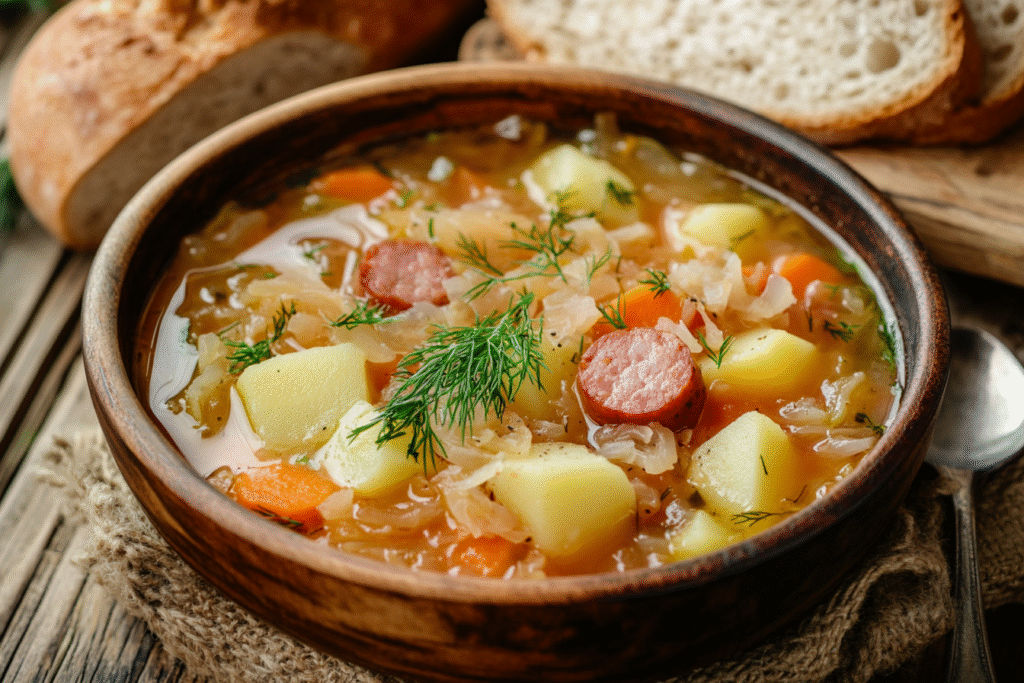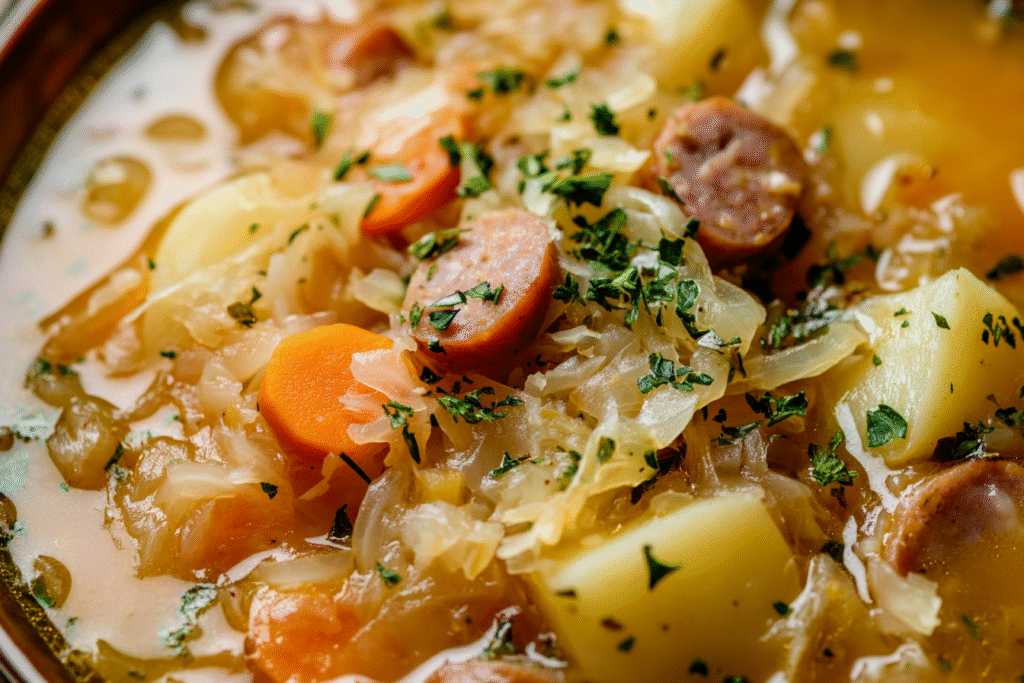Sauerkraut soup—known in many Eastern European countries as Kapustnyak—is a rustic, soul-warming dish that turns humble ingredients into something deeply nourishing and richly flavorful. At its heart, this soup is a marriage of tangy fermented cabbage and savory broth, often with the earthy addition of pork, potatoes, or grains. It’s the kind of meal that fills your home with the aroma of simmering comfort and leaves you feeling satisfied and centered.
This recipe for traditional sauerkraut soup is inspired by Ukrainian and Polish versions of the dish, yet is fully adaptable. Whether you’re looking for a brothy, lighter variation or a hearty, stew-like bowl, you’ll find guidance here. And if you’re new to cooking with sauerkraut, don’t worry—we’ll cover everything from selecting the right kind to balancing flavors, adjusting textures, and storing leftovers.
Why Sauerkraut Soup Deserves a Spot in Your Meal Rotation
Sauerkraut soup is more than just a cold-weather favorite—it’s a brilliant way to use up pantry staples and fermented foods. It also strikes that rare culinary balance of being both deeply satisfying and surprisingly good for you. Sauerkraut provides beneficial probiotics (especially if you use raw, unpasteurized varieties), while the soup itself is full of fiber, minerals, and natural flavor from real ingredients.
What sets sauerkraut soup apart is its bold, slightly sour base—rounded out by tender potatoes, soft-cooked onions and carrots, smoky bits of meat (if using), and fragrant herbs like bay leaf and dill. It’s the kind of dish that improves after a day in the fridge, making it ideal for meal prep or batch cooking.

Common Challenges (and How to Master Them)
Despite its simplicity, there are a few key details that can make or break your sauerkraut soup. Here’s how to avoid the most common pitfalls:
- Too sour: Sauerkraut varies in acidity. If your soup turns out too tangy, rinse part (or all) of the sauerkraut before adding it. You can also balance it with a bit of sugar or a potato.
- Flat flavor: Sauerkraut soup needs a rich base. Start with a flavorful broth (homemade is best) and don’t be shy with aromatics like garlic, onion, and bay leaf.
- Mushy texture: To maintain some texture, stagger when you add the ingredients. Add potatoes later in the cook time so they don’t break down.
- Over-salted soup: Since sauerkraut is already salty, wait until the end to season with additional salt.
Selecting the Best Sauerkraut
Not all sauerkraut is created equal. Here’s what to look for:
- Raw, unpasteurized sauerkraut: Found in the refrigerated section, this type retains probiotics and has a fresher, more complex flavor.
- Canned or jarred sauerkraut: More common and shelf-stable. Choose versions without preservatives or added sugar for the cleanest taste.
- Texture and cut: Finely shredded kraut will melt into the soup, while coarsely chopped adds more bite. Choose based on your preference.
🥄 Chef’s tip: If using very sour sauerkraut, rinse briefly under cold water and squeeze dry before adding it to the pot. You can also sauté it in a bit of butter or oil first to mellow its sharpness.

Ingredient Spotlight: The Flavor Builders
This soup is all about layers of flavor. Here’s what each main component brings to the table:
- Onions and garlic: The aromatic base that provides sweet depth.
- Carrots and celery: Add earthiness and body to balance the sourness.
- Potatoes: These soak up flavor and help mellow the acidity.
- Broth (vegetable, chicken, or pork): A high-quality broth makes all the difference.
- Smoked meat (optional): Sausage, bacon, or smoked ribs deepen the flavor with a hint of umami and smoke.
Optional add-ins include barley, white beans, or mushrooms for extra texture and heartiness.
Kitchen Equipment You’ll Need
The beauty of sauerkraut soup lies in its simplicity. You don’t need fancy equipment—just a few basics:
- Large Dutch oven or heavy-bottomed soup pot
- Wooden spoon or spatula
- Cutting board and sharp knife
- Ladle and bowls for serving
- (Optional) Immersion blender for a slightly blended texture
Flexible Substitutions and Dietary Tweaks
This recipe is adaptable to just about every dietary preference:
- Vegan/Vegetarian: Use vegetable broth and skip any smoked meat. Add mushrooms or smoked paprika for extra depth.
- Gluten-free: Naturally gluten-free as written—just check your broth and sausage ingredients.
- Low-carb/Keto: Skip potatoes and use cauliflower florets instead.
- Extra protein: Stir in cooked white beans or shredded cooked pork.
Boosting and Balancing the Flavor
Want to elevate your soup beyond the basics? Try these flavor enhancements:
- Add a bay leaf and a pinch of caraway seeds for classic Eastern European flavor.
- Use smoked paprika to mimic the flavor of meat in vegetarian versions.
- Deglaze the pan with a splash of white wine or apple cider vinegar for brightness.
- Top with a dollop of sour cream or Greek yogurt for creaminess and contrast.
- Garnish with fresh dill or parsley to freshen the finish.
Ingredients
For the Base:
- 2 tbsp olive oil or butter
- 1 medium onion, diced
- 2 cloves garlic, minced
- 1 carrot, peeled and diced
- 1 celery stalk, diced
- 1½ cups drained sauerkraut (rinsed if very sour)
- 1 medium potato, peeled and diced
- 5 cups vegetable, chicken, or pork broth
- 1 bay leaf
- ½ tsp caraway seeds (optional)
- Salt and black pepper to taste
Optional Add-ins:
- 1 cup chopped smoked sausage, ham, or bacon
- 1 tsp smoked paprika
- ½ tsp sugar (to balance acidity, if needed)
- Fresh dill or parsley, for garnish
- Sour cream or yogurt, for serving
Step-by-Step Instructions
Step 1: Sauté the Aromatics
Heat the olive oil or butter in a large soup pot over medium heat. Add the onion, garlic, carrot, and celery. Cook for 5–7 minutes, stirring occasionally, until softened and fragrant.
📝 Tip: Don’t rush this step—it builds the base flavor of your soup.
Step 2: Add the Sauerkraut
Stir in the sauerkraut and cook for another 5 minutes, letting it mingle with the aromatics. This mellows the tang and builds richness.
Step 3: Build the Broth
Pour in the broth, then add the bay leaf, caraway seeds (if using), and smoked paprika. Bring the mixture to a simmer.
If using meat, add it now. Let the soup cook gently for 10–15 minutes, allowing flavors to blend.
Step 4: Add Potatoes
Stir in the diced potatoes and continue simmering for another 15–20 minutes, or until the potatoes are tender.
Taste and adjust seasoning—add a pinch of sugar if the soup is too sour, or extra salt and pepper to balance.
Step 5: Finish and Serve
Remove the bay leaf. For a slightly thicker soup, use an immersion blender to partially blend about ¼ of the soup, or mash a few potatoes against the side of the pot.
Ladle into bowls and top with a dollop of sour cream or a sprinkle of fresh dill if desired.
Troubleshooting and Adjustments
- Too tangy? Rinse some of the sauerkraut, or add a small diced apple during cooking for natural sweetness.
- Too bland? Add more salt, paprika, or a splash of vinegar or lemon juice.
- Too watery? Let the soup simmer uncovered to reduce slightly or mash some potatoes to thicken.
Serving Suggestions
This soup pairs wonderfully with:
- Crusty rye or sourdough bread
- Smoked kielbasa or bratwurst on the side
- Pierogi or potato pancakes
- A crisp, acidic white wine like Riesling or Grüner Veltliner
It’s a great meal all on its own or as part of a larger Eastern European-style spread.
Storage and Reheating
To Store: Refrigerate in an airtight container for up to 5 days. The flavor improves as it sits!
To Reheat: Warm gently on the stovetop over medium heat, stirring occasionally. Add a splash of broth or water if it thickens too much.
To Freeze: Sauerkraut soup freezes well. Let it cool completely, then transfer to freezer-safe containers. Freeze for up to 3 months. Thaw overnight in the fridge and reheat on the stove.
Variations Across Regions
- Polish kapuśniak: Often includes pork ribs, barley, or tomato paste for a richer, reddish hue.
- Ukrainian kapustnyak: May feature millet or rice and is usually meatless during Lent.
- Slovak or Czech versions: Might use dried mushrooms, smoked meats, and caraway.
Each version carries the heart of its region, but they all celebrate sauerkraut as a cornerstone of comfort food. With this recipe as your base, you can start traditional and evolve with your own favorite add-ins.
Whether you’re deep into winter or just craving a hearty bowl of something comforting, this sauerkraut soup delivers depth, tradition, and soul in every spoonful.


